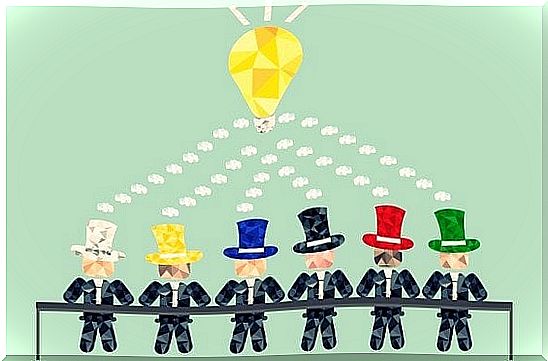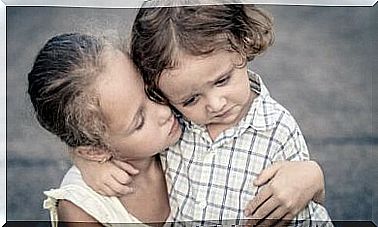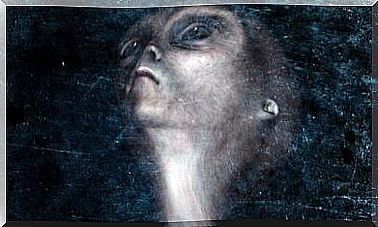Edward De Bono’s Six Thinking Hats Method

Many of you have probably already heard about it. If so, it probably helped you solve problems in a more creative way. The Six Thinking Hats method was developed by Edward de Bono. It is a tool for communication and reasoning. You use to see from new points of view by applying sideways thinking
Edward de Bono is now eighty-four years old. But he is still active. This psychologist from Malta is a professor at Oxford University. He left us an invaluable legacy in the world of creativity. His legacy has mainly influenced business management and leadership.
The Six Thinking Hats method is a classic dynamic for encouraging communication in the business world. But it is also often used as an exercise in universities and in elementary school classes. There it is used to teach children how to think better and make decisions in groups.
De Bono emphasizes one thing (as in his other books such as Practical Thinking, Water Logic, and The Use of Lateral Thinking). According to him, we all need to learn to think better. He also points out an interesting fact that is part of “we must.” It is the fact that we are actually also capable of learning to think.
Open yourself up to other points of view. Learn to be more flexible, thoughtful and original in your patterns of reasoning. Because it will not only help you make better decisions. It will also improve the quality of your relationships. Plus, it makes you more productive.
The method of the six thinking hats
Edward de Bono’s Six Thinking Hats method always follows the same pattern and strategy. At first it seems something simple. But it has an incredibly positive impact on the brain. That’s because it’s essentially “training” to learn how to think better.
De Bono says that something as simple as putting a hat on your head is often a thoughtful act. Your thoughts should also follow this rule: “be thoughtful and very careful.” Think carefully so that you can live better. That’s a rule worth following. The idea is that you use different “hats” so that you develop a varied, agile and creative style of thinking.
The method represents the six directions of thought as six imaginary hats. When a problem arises or you are trying to make a decision, each hat will be a preliminary statement, a vision, a specific framework. Once you’ve proactively set them all up, you’ll feel more ready to make a decision.
Now we want to see what each hat in the thinking method of the six thinking hats teaches us.
the white hat
This hat shows how to look at things from an objective, neutral and unbiased point of view. You use a thinking style that is based on the analysis of the facts. You compare the information that is available without making any value judgments.
- The white hat goes in search of concrete facts.
- He does not form interpretations or express opinions.
The black hat
The black hat represents the logical-negative side. It shows you why certain things can go wrong, don’t work or don’t happen the way you thought. The Six Thinking Hats method will also help you to be critical and see the negative side of things. So this will help you to be more realistic.
- Sometimes you need to be aware of difficult or complicated facts, or dead ends. You have to accept them so that you find a better way out.
- The black hat thinking style is based on your past experiences. They are thoughts that remind you of your mistakes from yesterday. They tell you it’s better to try new things and not fall into the same trap.
The green hat
- The green hat requires originality, creativity, crossing boundaries and making the impossible possible.
- It is this hat that involves the sideways thinking. It invites you to be challenging and less conservative.
- This way of thinking reminds you that it is not good to be satisfied too quickly. You have to look for other avenues to take. Or you can create other ways yourself, other alternatives, other possibilities…
The red hat
- The red hat is passionate, emotional and feels life from the heart.
- So the white hat helps us to be more neutral, cautious and objectively logical. But the red hat will throw you into the unknown. That way you can embrace a world of lively free subjectivity.
- When you put on the red hat, you will have the chance to say out loud what sets you on fire and what makes you uncomfortable. It is the moment when your intuition has to say something about the information you have. And it will also help you understand the emotions and needs of others.
The yellow hat
Thus, the black hat provides you with the logical-negative focus that is useful for being more realistic in your daily life. But the yellow hat will show you how to apply a logical positive focus.
- The yellow hat will open your eyes to possibilities where other people see closed doors.
- He will help you see things in a constructive and optimistic way.
- But this positivity and openness is always guided by logic. So you have to keep the logical view. Plus, don’t let your irrational passions take over. If you don’t, you will use the red hat and not the yellow one.
The blue hat

The blue color is all-encompassing. He is always there and checking everything. In addition, it conveys calmness, balance and self-control. In the method of the six thinking hats, it is this hat that keeps the whole process under control. This technique uses the blue hat twice: at the beginning and at the end.
- First you use the blue hat to decide which hats to put on and in what order. You then use it at the end to make a decision.
- This means that the blue hat represents structured thinking. For it is the core and your guide. He points out alternatives and proposes new strategies. At the same time, he maintains control at every point along the way. He will keep you from being distracted or lingering.
Edward de Bono’s Six Thinking Hats method is a useful strategy for making better decisions. You can use it to work on different thinking styles. Because they help you evaluate the problems and view the facts from all possible perspectives. At the end you will come to answers. Not only will they be more accurate, but they will also be much more creative and original.









